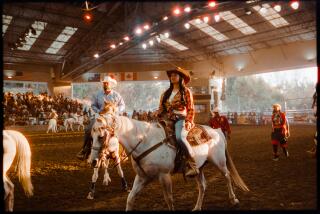The American Rodeo: The Bucking Doesn’t Stop Here : The West: The sporting event is one of the most accessible but also one of the hardest in which to make a living.
- Share via
LIVINGSTON, Mont. — Abe Morris slapped himself hard in the face. Then he did it again, three or four times.
“It sure does wake you up,” he explained.
Morris needed to be wide awake. A competitor on the professional rodeo circuit, he was getting ready to lash his hand to a ton of angry bull, which immediately tried to crush him against the walls of a narrow wooden chute.
Once Morris was settled on the animal’s back, he gave a nod, the gate was opened, and he put his spurs to the bull as hard and fast as he could.
Eight seconds of grueling whirlwind later, a whistle blew and Morris jumped off. A man in a clown suit ran up and swatted the still-bucking bull on the nose, distracting him while Morris made his getaway back to the chutes.
Using horns and hoofs, rodeo bulls have killed a number of riders and crippled many more, smashing legs, arms, ribs and every other bone known to mankind.
For risking his neck, Morris scored 67 points and earned just enough money to cover his entry fee. But by breaking even he did a lot better than most riders that night.
“Most guys aren’t making any money at this. In fact, most are losing money,” said Gavin Ehringer, spokesman for the National Professional Rodeo Cowboy Assn. in Colorado Springs, Colo.
Rodeo is by far the most accessible of American professional sports. Anybody who can scrape together a few dollars for an entry fee can try to ride a bronco or a bull in thousands of events all over the country.
But it is also one of the hardest sports in which to make a living. Getting on a bull or a bucking horse is one thing. Staying on long enough to win some money is another.
Ty Murray, the 1990 world champion, grossed $213,000 that year. That is a lot of money, but it pales by comparison to the multimillion-dollar payoffs in baseball, football and basketball.
The top 10 to 15 people in each rodeo event win between $35,000 and $70,000 a year, Ehringer said.
Most of the 9,500 professionals in the sport fall far shy of that figure, and they have to pay for their almost constant travel out of what they win.
All for the pleasure of risking permanent injury.
Although rodeo does not get the television coverage of major team sports, it attracts as many live spectators to its dusty arenas as National Football League games do, Ehringer said.
Rodeo events revolve around the roping and riding skills needed by the Wild West’s early cowboys.
In the days of the open range and big cattle drives, an activity like bulldogging--diving off a horse onto a steer’s neck and wrestling it to the ground by the horns--had practical value.
Since proper fences and corrals now make it unnecessary, hardly anybody does that sort of thing outside a rodeo arena.
Calf-roping still has some practical value on working ranches, as does knowing how to stay on a bucking horse, but most rodeo events are displays of athletic rather than practical skill.
Cowboys and animals are considered athletes and are scored as such by judges.
But rodeos are no longer just for cowboys.
Morris is a good example. Reared in New Jersey, he began riding there more than 20 years ago and has been in professional rodeo for 13 years. Most of the year, he earns his living by selling annuities.
The rodeo association sanctions 750 rodeos a year, and all participants in those events must be members of the organization.
But thousands of non-sanctioned rodeos are held, peaking during the summer months. Those are the type of events where anybody with nerve and an entry fee can try his luck.
Rodeo is definitely a young man’s sport. The average age for riders in the “rough stock” events--bull riding, bareback bronco riding and saddle bronco riding--is 26 or 27, Ehringer said.
“Your career in rough stock riding is effectively over by the time you’re 30,” he said.
But like any rule, this one has exceptions. Morris, who rides bulls, the roughest of the rough stock, hesitated to give his exact age but acknowledged that it is considerably over 30.
“Maybe I’ll tell everybody how old I am when I finally decide to quit,” he said.
More to Read
Sign up for Essential California
The most important California stories and recommendations in your inbox every morning.
You may occasionally receive promotional content from the Los Angeles Times.













